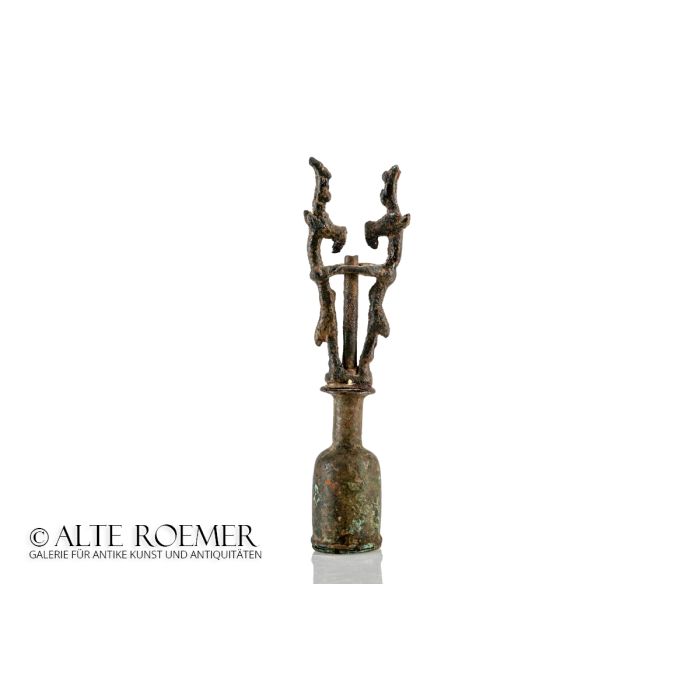Luristan bronze standard with ibexes
€840
available
Object number
AR3171
| Object: |
Luristan bronze standard with ibexes
|
| Material: |
Bronze.
|
| Period: |
8th century BC to 7th century BC. Iron Age of Luristan. |
| Description: |
Bronze standard with stand from Luristan. This variant with animal decorations is referred to in literature as "master-of-animals". The stand is formed by an elongated, cylindrical base with a cylindrical neck that ends in a wide lip. A decorative rim is located at the bottom of the base. The large opening at the bottom was used for attachment to a staff. The small opening at the top for attaching the standard with a pin, as is the case for this ensemble. The standard is a heavily decorated staff. The decorative elements run in one plane and consist of two mirror-symmetrical pairs of stylized, standing rams. At the top of the standard were once further decorative elements as a finial, which are now missing. |
| Background: |
The standards are curious artefacts from the Luristan culture. They have no real parallels outside of this region of present-day northern Iran. In German-language literature they are referred to as standards, votive statuettes or lucky charms. The English-language literature often uses the word finial, which does not imply any function. And indeed, what they were really used for is still a mystery. Roger Moorey (see literature references) speculates that they could be household gods, as they are mentioned several times in the Old Testament as so-called teraphim (e.g. Gen 31:19 ELB, 1 Sam 19:13 ELB and Hos 3:4 ELB ). These gods were used for divination and to protect households and businesses. They were placed in sacred niches or hidden from view. |
| Dimensions: |
172mm height.
|
| Condition: |
The upper part of the standard is broken off and missing, but the side decorations, the stand and the staff are completely intact. Strong patina. A head of the ornament has broken off and has been reattached relatively loosely with glue.
|
| Provenance: |
Acquired by us in 2021 from Robert Deutsch, Israel. Exported under Israel Antiquities Authority permit no. 44527. Previously in the collection of Dr. Kurt A. Moosberg, Israel, collection number M 74. Acquired in March 1960. The name "Mollayem" is handed down by the inventory card of the Moosberg collection and probably refers to the collection of Mr. Molayem, who built it up in Rome in the 1950s. Parts of it were sold again in the 1960s.
|
| References: |
The following literature references were passed down for this piece, R. Ghirshman, Iran (Pelican, 1954), p. 102, plate 7b. Prezeworski, Archaeologia 88 (1938), p. 255 and 258f, no. 28, plates 76e-h and 77d. L. Legrain, Luristan Bronzes in the University Museum (Philadelphia, 1934), no. 6. |
| Literature: |
Several examples for standards from Luristan can be found in the more recent book from G. Zahlhaas, Luristan - Antike Bronzen aus dem Iran (Munich, 2002). For an insightful treatise on Luristan standards, see P.R.S. Moorey, Ancient Bronzes from Luristan, pp. 29ff. |
| Authenticity: |
We unconditionally guarantee the authenticity of every artefact, all items are subject to our lifetime return policy on authenticity.
|


